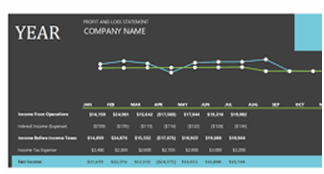ACCOUNTING AS ASOURCE OF INFORMATION
Accounting is a definite process of interlinked activities, that begins with the identification of transactions and ends with the preparation of financial statements.
Every step in the process of accounting generates information.
Generation of information is not an end in itself. It is a means to facilitate the dissemination of information among different user groups.
Such information enables the interested parties to take appropriate decisions. Therefore, dissemination of information is an essential function of accounting.
To be useful, the accounting information should ensure to:
• provide information for making economic decisions;
• serve the users who rely on financial statements as their principal source of information;
• provide information useful for predicting and evaluating the amount, timing and uncertainty of potential cash-flows;
• provide information for judging management’s ability to utilize resources effectively in meeting goals;
• provide factual and interpretative information by disclosing underlying assumptions on matters subject to interpretation, evaluation, prediction, or estimation; and
• provide information on activities affecting the society.
USERS OF ACCOUNTING INFORMATION
Owners: The owners provide funds or capital for the organization. They possess curiosity in knowing whether the business is being conducted on sound lines or not, and
whether the capital is being employed properly or not. Owners, being businessmen, always keep an eye on the returns from the investment. Comparing the accounts of various years helps in getting good pieces of information.
Management: The management of the business is greatly interested in knowing the position of the firm. The accounts are the basis, the management can study the merits and
demerits of the business activity. Thus, the management is interested in financial accounting to find whether the business carried on is profitable or not. The financial accounting is the “eyes and ears of management and facilitates in drawing future course of action, further
expansion etc.”
-
Creditors: Creditors are the persons who supply goods on credit, or bankers or lenders of money. It is usual that these groups are interested to know the financial soundness before granting credit. The progress and prosperity of the firm, two which credits are extended, are largely watched by creditors from the point of view of security
and further credit. Profit and Loss Account and Balance Sheet are nerve centers to know the soundness of the firm
-
Employees: Payment of bonus depends upon the size of profit earned by the firm. The more important point is that the workers expect regular income for the bread. The demand for wage rise, bonus, better working conditions etc. depend upon the profitability of the firm and in turn depends upon financial position. For these reasons, this group is interested in accounting.
Investors: The prospective investors, who want to invest their money in a firm, of
course wish to see the progress and prosperity of the firm, before investing their amount, by going through the financial statements of the firm. This is to safeguard the investment. For this, this group is eager to go through the accounting which enables them to know the safety of investment.
Government: Government keeps a close watch on the firms which yield good amount of profits. The state and central Governments are interested in the financial statements to know the earnings for the purpose of taxation. To compile national accounting is essential.
Consumers: These groups are interested in getting the goods at reduced price. Therefore, they wish to know the establishment of a proper accounting control, which in turn will reduce to cost of production, in turn less price to be paid by the consumers.
Researchers are also interested in accounting for interpretation.
Research Scholars: Accounting information, being a mirror of the financial performance
of a business organization, is of immense value to the research scholar who wants to make a study into the financial operations of a particular firm as such study needs detailed accounting information relating to purchases, sales, expenses, cost of materials used, current assets, current liabilities, fixed assets, long-term liabilities and share-holders funds
-
The accounting system concerned only with the financial state of affairs and financial
results of operations.
-
It is the original form of accounting. It is mainly concerned with the preparation of financial statements for the use of outsiders like creditors, debenture holders, investors and financial institutions.
These users can be divided into two broad categories: internal users and external users.
Internal users include: Chief Executive, Financial Officer, Vice President, Business Unit Managers, Plant Managers, Store Managers, Line Supervisors, etc.
External users include: present and potential Investors (shareholders), Creditors (Banks and other Financial Institutions, Debenture holders and other Lenders), Tax Authorities, Regulatory Agencies (Department of Company Affairs, Registrar of Companies, Securities Exchange Board of India, Labour Unions, Trade Associations, Stock Exchange and Customers, etc.
- Books Name
- CA Shivali kedia Accountancy Book
- Publication
- CA Shivali kedia
- Course
- CBSE Class 11
- Subject
- Accountancy
Accounting as Source of Information
Accounting provides a) relevant information to users of financial statements, so that they can be b) informed decisions (On the basis of the financial statements). It helps users analyze the risks and uncertainties and ways to mitigate (minimize) them.
Let us understand the qualitative characteristics of Accounting!
Reliability
Imagine in our cafe Harsh has had an accountant. But the accountant is not a good person the accounting information expenses sales his recording are not true there all fall at the end of the year Harsh will not people to rely on that data is not true hence the first characteristic qualitative characteristic of data is it should be reliable and true
Relevance
The data has to be relevant to the user of the financial statements because data helps in making the decisions in the future data is the basis of making the decisions about the business in the future.
In short, no one can rely on decisions made when the accounts are all wrong and unreliable,

Understandability
In accountancy, we learn how to deal and interact with books of accounts and financial information. Sometimes there is no face-to-face communication between the accountant and the owner. At the end of the year, the accountant sometimes might just hand over the accounts to the owner.
Understandability explains refers to that the accounts should be prepared in such a way that even if there is no physical interaction the book of books of account should be self-explanatory to the person who is reading them understandability is very important for communication of financial information

Comparability
The accounting information should be comparable to the previous year’s information.
Sometimes the businesses compare their performance with the performance of similar companies in the industry.
Hence accounts should be prepared in such a way that they can be easily compared with in previous years and within our competitors as well

- Books Name
- Vision classes Accountancy Book
- Publication
- Vision classes
- Course
- CBSE Class 11
- Subject
- Accountancy
ACCOUNTING AS ASOURCE OF INFORMATION
Accounting is a definite process of interlinked activities that begins with the identification of transactions and ends with the preparation of financial statements.
Every step in the process of accounting generates information.
Generation of information is not an end in itself. It is a means to facilitate the dissemination of information among different user groups.
Such information enables the interested parties to take appropriate decisions. Therefore, dissemination of information is an essential function of accounting.
To be useful, the accounting information should ensure to:
• provide information for making economic decisions.
• serve the users who rely on financial statements as their principal source of information.
• provide information useful for predicting and evaluating the amount, timing and uncertainty of potential cash-flows.
• provide information for judging management’s ability to utilize resources effectively in meeting goals.
• provide factual and interpretative information by disclosing underlying assumptions on matters subject to interpretation, evaluation, prediction, or estimation.
• provide information on activities affecting the society.

 SS MUKHI
SS MUKHI
